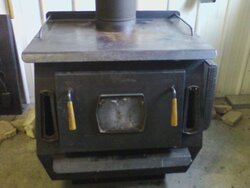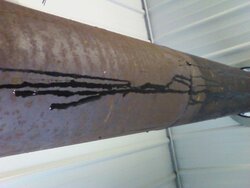farmkid2 said:
Here are a couple pics. When cold, the flapper is closed with the knob pointing to the 2nd lowest setting. Does that sound right?
Looks just like my old stove. Had colored ceramic inset pieces on the front.
Good you found the problem.
Easy fix?
Next deal with the creosote forming itself. Wet wood most likely.
Get the pipe good & clean & inspect it often.
I had to brush my flue monthly when I first burned but wasn't using dry wood. My wood then was 3 or 4 months seasoned.
Had one chimney fire, which wakes you up to the dangers, so I bought brushes & rods & cleaned monthly. always got quite a bit too.
The older BK when burning on low don't heat the flue hot when burning on low & inherently cause the gasses to condensate inside the pipe & form creosote.
Drier wood helps. really dry wood is even more help, less moisture in the exhaust gasses & less condensation.
You can help some by using double wall pipe out of the stove to the pipe at the ceiling. It will keep the flue hotter & the gasses should condensate as quickly.
I learned to burn hotter & rarely burned on the lowest settings, that helped keep the chimney cleaner too.
But most of my problem was not using well seasoned dry wood. Learned allot since those days. Most of it here.
Your stat won't be the same as mine, they can change over time. I would check it when the stove is hot & see where it closes. (& try that as the low setting) The flapper moves really slow so testing will take a few hours.
Cold stove & closing at the 2nd lowest setting, well that's not letting air into the stove (& the stove is cold) so that may be the "OFF" or no air setting. Going that low will more than like smolder the fire & put it out.
It may be a good setting once you only have hot coals in the stove but not a good burning setting.
It's hard for me to remember but I think I mostly burned at the 1/2 way setting. We'd get all night burns (8 to 10 hours) with full loads. (but again, I have much better, drier wood now)
Burn it on high for 30 minutes or so then turn it down mid range & see how the damper reacts.
Just pull the cover off & look then put it back, with the cover off more air goes into the stove. I'd use it to get a good raging fire (stat wide open) going then put it back on, book said not to, but I learned that you can get a good hot fire going faster with more air in the back.
I also tried to burn a good hot fire every morning, sometimes I'd hear creosote falling back into the stove after a good hot fire. I originally had a straight up thru the ceiling similar to yours.
Hope this helps. Each stove & system is a bit different, learning & tweaking for best operations of your set up is fun.
I though it was a good stove & it heated my house for several years burning 10 cords every winter. Learning the "sweet spot" for low is good to know & again well seasoned dry & drier wood yet, is important. Really important. I learned the hard way.





